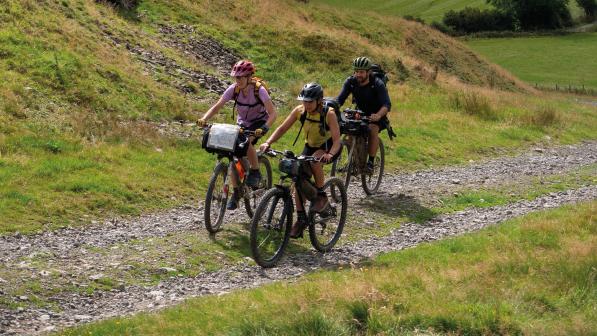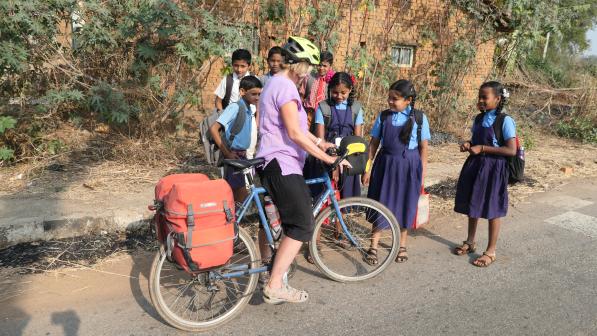Great rides: A handcycle ride to Hope

We envisioned gliding through palm groves silhouetted by the setting sun over the Arabian Sea, cruising along quiet stretches of tarmac beside serene sandy beaches and passing through sleepy Keralan hamlets punctuated by vibrant fishing villages. It would be an experience full of colour, warmth and sensory delight.
We were heading to the south-western coast of India because an invitation to a festival of inclusion in Goa coincided with a chance to visit the Hope Community Village for children in Kerala.
It seemed like the perfect opportunity to connect the locations with a cycling tour. It was January, and the thought of escaping a grey European winter and embarking on a warm bike adventure was irresistible.
My trusted steed for this journey was my first racing handbike, originally acquired during my preparation for the London 2012 Paralympics. It has been through a lot – smashed a few times, repaired and patched up, much like me – but it soldiers on. It seemed a suitably resilient machine to rely on for an adventure in India.
My partner, Glyn Stanworth, opted to source a bike locally in India, avoiding the expense and hassle of transporting one from home. In a bike shop in Panjim, Goa, he selected a low-budget model that the shop owner assured us was “India’s top, up-and-coming brand”.
A broken bike, a late night
Eager to get moving again after a week of conference hospitality and an excess of local Goan cuisine, we heeded advice to start our journey 100km south on the coast, near the smaller town of Karwar.
From there it was an 800km ride south, never far from the coastal artery road (the N66). We would pass through southern Goa and the state of Karnataka, and eventually reach Hope Community on the outskirts of Alappuzha in Kerala.
My handbike resembled a wagon train, with my wheelchair lashed to the back of my long recumbent, luggage thrown into its seat and additional bags strapped to the rear. With no camping equipment, we were traveling relatively light.

Just 700 metres into our journey, one of the pedals on Glyn’s bike came loose. The thread was already stripped, and we began an urgent search for a new crank arm. It seemed that ‘India’s top cycle brand’ was not so top!
However, the wonderful thing about countries with less of a throwaway mentality is the willingness to mend, repair and improvise solutions. Though it took most of the day, we eventually got back on the road, eager to make up for lost time.
As the sun dipped lower, we found ourselves in the countryside between towns. With no accommodation at hand and no tent to rely on, we chased the fading light. Despite our intention never to cycle in the dark in India, we found ourselves obliged to do so.
With two bikes and a wheelchair, hitching a ride wasn’t always an option. Even the usually ubiquitous rickshaws had disappeared just when we needed them most.
My head torch reflected off the hand cranks, blinding me as it bounced light back into my eyes. Squeezed between a rocky escarpment and traffic trying to navigate the narrow, winding road, I felt a surge of adrenaline and a knot of fear in my stomach.
Every instinct screamed that we shouldn’t be night riding. I was dismayed by the predicament we’d landed ourselves in, and I found myself silently thanking in advance the Indian gods for keeping us safe.
Three hours after nightfall, we finally reached the turnoff from the main road. Although we were still riding in darkness, the more peaceful country lanes that wound through dense vegetation and backwaters allowed us to relax a bit as we headed towards the small town of Gokarna and a bed for the night.
Instagramming the journey
We continued our journey south along winding roads, passing through lush hills thick with jungle, and descended to emerald green waters dotted with boats. A small ferry carried us across the water and a cooling breeze evaporated our sweat and reinvigorated us for the afternoon’s challenging terrain.
As we meandered through quaint villages, we were often greeted by the sounds of music, dance, drumming or colourful temple events. The festive atmosphere, along with refreshing lime sodas and spicy samosas, lifted our spirits and propelled us south.

People we met along the way radiated a warmth and joy that was palpable. Their infectious smiles made us smile wider too, and we were enchanted by their generosity and apparent happiness.
“Instagram?” called the young men that passed us on mopeds. As I called out “handbikedarke”, followers rose exponentially. Gradually we were greeted by strangers who had anticipated us via their friends’ social media feeds. Despite the poverty we also witnessed, we were riding through a smartphone-connected country.
As we settled into life on the move, we noticed that Kerala’s roads were smoother, the surroundings cleaner and the vibe more relaxed. However, the road was undergoing a major upgrade to a wide highway with barriers and a central reservation.
Navigating this massive construction site proved challenging, with rough sections, frustrated drivers and clouds of dust.
While the landscape remained beautiful in many places, the scars of development were evident. Concrete and tarmac encroached on what was once a thriving ecosystem. I felt sadness for what was lost.
Out in the midday sun
The founder of Hope Community Village, a Yorkshireman named John Veitch, had cycled from Hope to Goa on a fundraising journey back in 1996. Nearly 30 years later, we found ourselves inadvertently cycling his route in reverse. We learned that John’s journey had often taken him further east, into the hills of the Western Ghats.
He shared his memoir with us. “I wasn’t short of advice from all directions, particularly on the route, places to stay and places to avoid. Much of it I ignored, but the best advice – to set off early each day to avoid cycling in the midday sun – I gladly followed.
“Everyone was concerned about how I would handle the chaotic traffic, and it didn’t take long to realise they were right to be.”

Though separated by three decades, our concerns mirrored his. The heat was relentless, scorching us even in the early hours. The traffic was erratic and unnerving. Despite our best efforts to start early, the sun’s rays would quickly penetrate our jerseys, leaving us drenched in sweat that dried into white salt stains.
Mechanical issues with our ‘quality Indian bike’ often disrupted our morning progress, forcing us to pedal through the sweltering midday heat.
The traffic was more alarming than on any previous journeys I had taken in India – faster and busier, with express buses barrelling down on us unpredictably. While we were grateful for the chaotic mix of rickshaws and bikes that kept drivers alert and slowed the general pace, there were moments when it felt like a dangerous game of roulette.
We adapted our route, opting for smaller, winding lanes that led us through beach fronts, jungles, villages and narrow paths weaving between homes and gardens. This safer, more scenic path allowed us to engage more closely with local life.
While navigation could be challenging and our progress southward slowed, we found the peaceful cycling and beautiful landscapes we had earlier envisioned.
When we couldn’t avoid treacherous areas or busy roads over major bridges, we chose survival and flagged down local rickshaw trucks or similar vehicles to shuttle us safely around the danger zones.
Ending with Hope
Finally, we experienced the true joys of cycle touring in Kerala. A friendly local family invited us to stay with them for the night. Ahmed, a young cyclist from the Kerala Cycle Club, found us on the road and joined us for a few days. His enthusiasm was infectious and his vibrant club jersey a stark contrast to the worn condition of his bike and tyres.
We were amazed at how far he rode, navigating potholes in the darkness with no lights, with no snacks and very limited water. We admired his resilience and passion for the sport, and felt grateful for the equipment and resources we had.

In between riding we immersed ourselves in Kerala’s rich culture and history. We gazed down from the walls of the ancient fort in Bekal, which stand sheer above the Arabian Sea, and wandered the alleyways of Fort Kochi, bustling with hippy tourists.
Glyn took some refreshing evening dips in the sea. I wished I could swap my skinny wheelchair tyres for my ICE Full Fat wheels to whisk me over the sand.
Sky merged with water, and the sun sank into a faraway horizon. Rustling palms lulled us to sleep. One night in an Ayurvedic spa provided a luxurious contrast to our usual mosquito-ridden lodgings, with plank-hard beds and rickety fans.
As we settled into the rhythm of life on the road, the end of our journey was already in sight. We got news that some of the children from the Hope Community Village would greet us on their bikes and ride the final few kilometres with us through the lanes to the gates of Hope. We arrived through a funnel of cheering children and staff, an incredible welcome and end to our journey.
The children in Hope effuse joy and fun, despite the tough starts they have all had. They were a reminder, as was our whole tour, that whatever our circumstances, our attitude and a supportive environment act as balm for our souls.
Cycle magazine
Every two months Cycling UK members receive Cycle magazine, filled with interesting and informative articles, news and reviews for all cyclists.
Members can read the magazine in full online; non-members can read selected highlights.



